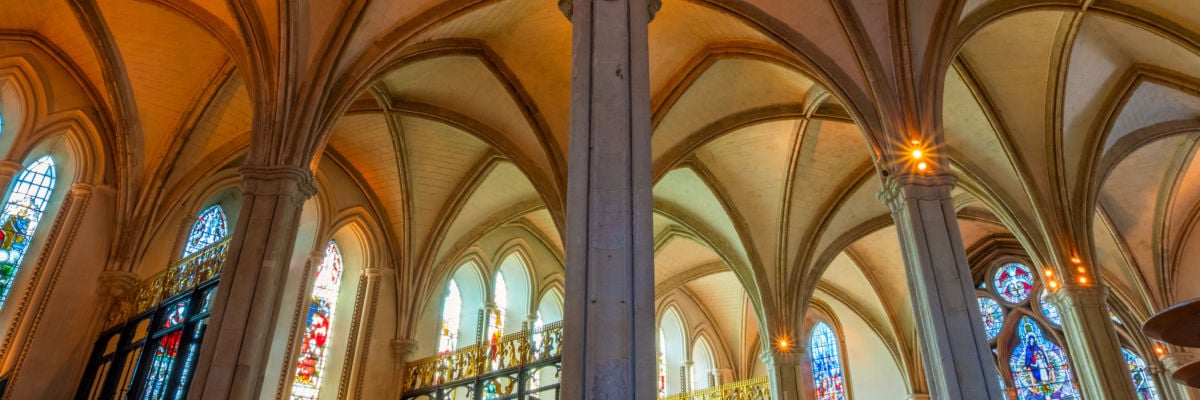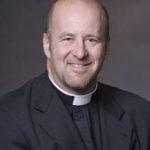
Anyone with a love of history, literature, and culture would find it difficult to resist the appeal of the Anglican Church. With some of the finest architecture in Christendom, an exquisite tradition of sacred music, fine liturgies with splendid hymns, Anglicanism takes all that is most refined, educated, eccentric, and traditional about England and filters it through the Christian faith.
The expression of the Christian faith we call Anglicanism is now in terminal decline. Pope Benedict XVI’s recent lifeline to disaffected Anglicans makes it imperative for Catholics to understand present-day Anglicanism. Much of the ecumenical adventure between Anglicans and Catholics over the last 40 years has been fruitful, but its success has been limited because many Catholics do not understand the complexity of the Anglican church. The sort of Catholic apologetics often used with Evangelical Christians is ineffective for Anglicans. To approach Anglicans and to be able to answer their questions about the Catholic Church, we have to understand Anglicanism from the ground up.
English to Its Core
The story of the English Reformation is more complex than people realize. In England, the Reformation was more a revolution. The dissolution of the monasteries brought about a redistribution of wealth so radical that nothing like it was seen until the French and Russian Revolutions. As the monasteries were dissolved, the entire educational, social welfare, and health care systems collapsed. The monastic lands and riches were simply taken by the king and given to his cronies.
Over time, the effect was to identify the Church of England not only with the monarchy, but with Englishness. Members of the Church of England hold their Christianity in one hand and their Englishness in the other, and they pray by putting their two hands together. Converts to the Church of England often do not realize the depth of this union of Christianity and English nationalism. More importantly, many Anglicans are unaware how much their Christian faith is defined by their English culture.
This means that Englishness is written in and through the Anglican religion in a far deeper way than Scottish culture is written into Presbyterianism or German culture into Lutheranism. Without having a firsthand experience of this blend of religion and culture, it is impossible to understand the heart of Anglicanism.
Global Growth
Anglicanism began to travel as the English began to travel. First it came to the American colonies. For political reasons, Anglicans in America had their bishops consecrated by the Scottish (who were also anti-English). Because Anglican means English, both the Scottish and American Anglicans chose the name Episcopal, meaning “with bishops.”
During the expansion of the British Empire, the Anglican church also spread to Australia, New Zealand, Canada, and the other British colonies—most notably in Africa through the work of the Victorian missionary societies. As the Anglican church spread, each national church was given its own hierarchy and as the colonies eventually gained independence, so did their national churches. The result was the Worldwide Anglican Communion.
It is easy to think that the worldwide Anglican church is rather like the Catholic Church. We have the pope in Rome; they have the Archbishop of Canterbury. But nothing could be further from the truth. There is no central authority in the Anglican church. Each of the national churches are independent provinces. The Archbishop of Nigeria has complete authority in Nigeria and owes no real obedience or loyalty to the Archbishop of Canterbury. The same applies to all the national churches. The Episcopal church of the United States, the Anglican church of Canada, and all the other national churches are held together only by a shared Anglican ancestry.
Three Ways to Be Anglican
Or is it 300? While all the national churches that make up the Worldwide Anglican Communion are independent, they also have particular theological complexions. Depending on the churchmanship of the missionaries who went there, the different national churches might be Anglo-Catholic or Evangelical—or they may have gone liberal.
This leads us to the next bewildering aspect of Anglicanism. From the time of the Reformation there have been Anglicans who have been more Catholic in their theology and understanding of the church and there have been those who have been more Protestant. The two have always existed in an unhappy tension within the Anglican church.
I attended an Anglican seminary of the Evangelical persuasion called Wycliffe Hall, and down the road was the Anglo-Catholic seminary called St. Stephen’s House. The two were totally opposed in theology, liturgical practice, culture, and ethos. In Oxford was an Anglican seminary which was “broad church,” or liberal. This third strand of Anglicanism has always been a kind of worldly, established, urbane type of religion that is at home with the powers that be and always adapts to the culture in which it finds itself.
These three forces co-exist in the Anglican church—united by nothing more than a shared baptism, a patriotic allegiance to the national church, and the need to tolerate each other. Unfortunately the toleration frequently wears thin. The Anglo-Catholics, the Evangelicals, and the liberals are constantly at war. Their theology, their liturgy, their politics, and their spirituality are in basic contradiction to one another.
Other influences have complicated things further, and the three main strands of Anglicanism have divided into sub-strands depending on the influences of various individuals and movements. Just about every permutation and mixture of politics and religion is found within the Anglican church.
Stranger and Stranger
Are you confused yet? It gets thicker. Since the mid-19th century the Anglican Communion has been slowly disintegrating. This has happened through breakaway groups who maintain the Anglican traditions but have set up their own structures and founded their own churches and communions.
In 1976 the Episcopal church voted to ordain women, and in 1979 it promulgated a new and controversial version of its prayer book. This prompted several new breakaway movements, and these movements fractured among themselves. The Continuing Anglican movement was thus born out of the conflicts in the Episcopal church. This fracturing continued for the next 30 years with more and more Continuing Anglican churches being formed. Some of these churches were Evangelical; some Anglo-Catholic. The movement spread throughout the world so that now there are over 150 independent Anglican churches around the world.
Recently, in the wake of the consecration of an openly gay bishop, even more Anglicans have broken away. This new batch of disaffected Anglicans—largely Evangelical and led by bishops in the developing world—do not wish to form a new church. Instead they have come up with the novel solution of remaining within the Anglican Communion, but operating with a parallel hierarchy and international board of cooperation and finance. Instead of splitting they aim to remain within and be a “prophetic voice” within the Anglican church (or a thorn in its side, depending on your perspective).
The dissident groups led by the bishops of the developing world sense that they have numbers on their side. There are more practicing Anglicans in Nigeria alone than there are in England, America, and Canada combined. These New-World Anglicans are flexing their muscles and fighting for the future of the Anglican church.
Pope Benedict’s Lifeline
In the midst of this bewildering complexity, what does Pope Benedict hope to accomplish by setting up a new Anglican structure in communion with the Holy See? First of all, he understands the intricate complexity of Anglicanism. The Holy Father is not attempting to take over the whole Anglican church and annex the Anglican Communion. Such a venture would be completely impossible. The liberals and Evangelicals would never accept Catholic dogmas or the authority of the pope.
Neither is the Holy Father attempting to poach Anglo-Catholics. Instead he is responding to the pleas from thousands of lay people, clergy, and bishops within the Anglo-Catholic wing of the Anglican church. These individuals are mostly within the continuing Anglican churches. The Traditional Anglican Communion is a confederation of perhaps 500,000 Anglicans worldwide who belong to various breakaway denominations of an Anglo-Catholic complexion. Some of them may respond positively to the pope’s offer. In addition, some Anglo-Catholics within the Church of England and Episcopal church may find a way to come into full communion with the Catholic Church.
If they do, they will be following the path of the pioneering former Anglican clergy who are already ordained under the Pastoral Provision, which allowed married former Anglican priests to be dispensed from the vow of celibacy and to be ordained as Catholic priests. Most of them serve within the existing diocesan structures as Latin-rite Catholic clergy. However, a few in the United States serve within their own Anglican Use parishes. These are personal parishes within existing dioceses where the Vatican-approved Anglican Use Latin-rite liturgy is used. Pope Benedict’s new offer builds on the existing structures and provides not only for former married Anglican clergy to be ordained as Catholic priests, and not only for there to be Anglican Use parishes, but for these clergy and parishes to have their own “ordinary”—a former Anglican priest or bishop who will oversee the parishes and clergy in cooperation with the local diocesan bishop. This means Anglican converts will have an advocate who understands their peculiar situation and can help them come home to Rome easily and quickly.
What Next?
Catholics who want to welcome Anglicans need to understand a bit more about the Anglican mentality.
Anglo-Catholics consider themselves to be Catholics within the Anglican Church. Furthermore, many traditionalist Anglo Catholics see the liturgical abuses, liberalism, and spiritual decay within the Catholic Church and believe themselves to be more faithful to Catholicism than most Catholics.
The typical Anglo-Catholic will look, pray, and worship in a way that looks like a traditional Catholic’s style of worship. He will use Roman liturgies, keep the Roman calendar, pray the rosary, and be Catholic in everything but full communion with the Holy See. The task for the Catholic apologist is to help him see that this one thing he lacks is the most important thing.
The traditionalist Anglo-Catholic is very similar to a traditionalist Catholic group in his mentality. He believes himself to be part of a remnant of true believers whose job it is to keep the faith and stand firm, while all the others in his church drift into moral decay, heresy, schism, and apostasy. Rather than seeing full communion with Rome as the answer, he sees it as going out of the frying pan into the fire. He is not convinced that Rome is any purer than the Anglican church.
The bottom line in discussion with Anglicans is the question of authority. Should the Catholic apologist point to the disarray within Anglicanism the Anglican may well reply, “You Catholics have just as much variety and dissent and division in your ranks.”
To which we must say, “That may be, but we do not claim it as a virtue. We have one authority on earth. We have one clear teaching. We may not all obey it. We may not all unite around it, but it is there. It is one. It is holy. It is Catholic. It is apostolic. It is a rock on which to build, and the rock is Peter and his successor.”



